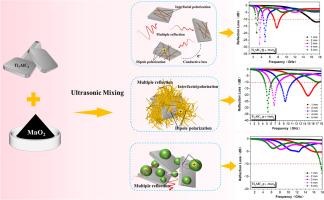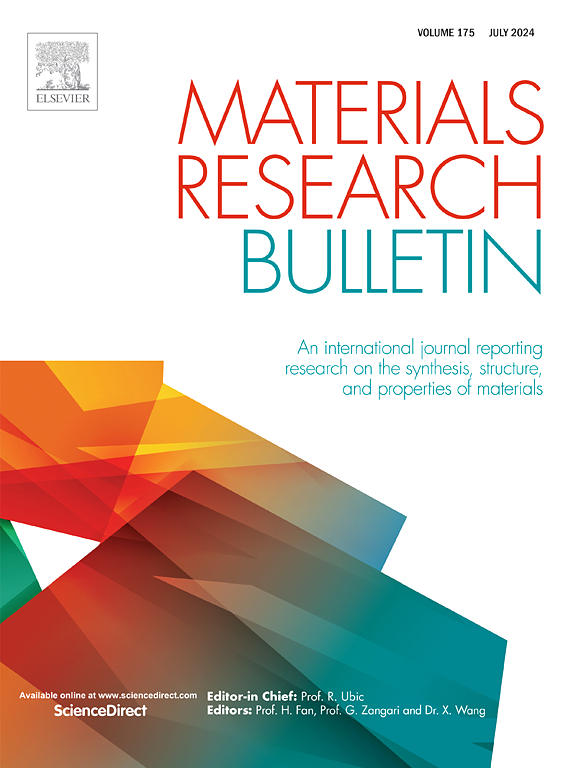Interfacial polarization of different MnO2 crystal anchored on Ti3AlC2 to enhance the microwave absorption
IF 5.3
3区 材料科学
Q2 MATERIALS SCIENCE, MULTIDISCIPLINARY
引用次数: 0
Abstract
Hierarchical MAX phase materials constructed with different MnO2 crystal were designed for microwave absorbers. Different MnO2 crystal loaded on Ti3AlC2 had an abundant and differentiated interfaces. Compactly loaded on the surface of Ti3AlC2, α-MnO2/β-MnO2 was a nanorod and δ-MnO2 was a flower, but ε-MnO2 was spherical separating from the Ti3AlC2. Relying on the synergistic effects of the interfacial and defect dipole polarizations, the optimal RL of Ti3AlC2@α-MnO2 and Ti3AlC2@β-MnO2 hybrids were -46.5 dB at 3.6 mm and -44 dB at 2.7 mm, respectively. The RL of Ti3AlC2@δ-MnO2 hybrid was regulated by the matching thickness (-46.8 dB at 6.1 mm and -20 dB at 2 mm) and the broad EAB is 4.84 GHz. However, the RL of Ti3AlC2@ε-MnO2 hybrid cannot reach -10 dB within the thickness of 1.0–5.0 mm, demonstrating the worst attenuation performance. This work offers an opportunity to elucidate the relationship between heterogeneous interface and microwave absorption.

锚定在 Ti3AlC2 上的不同 MnO2 晶体的界面极化以增强微波吸收
用不同的二氧化锰晶体构建的分层 MAX 相材料被设计用于微波吸收器。负载在 Ti3AlC2 上的不同 MnO2 晶体具有丰富且不同的界面。紧密负载在Ti3AlC2表面的α-MnO2/β-MnO2呈纳米棒状,δ-MnO2呈花状,而ε-MnO2则呈球状与Ti3AlC2分离。依靠界面极化和缺陷偶极极化的协同效应,Ti3AlC2@α-MnO2 和 Ti3AlC2@β-MnO2 混合物的最佳 RL 分别为 3.6 mm 时 -46.5 dB 和 2.7 mm 时 -44 dB。Ti3AlC2@δ-MnO2 杂化物的 RL 受匹配厚度的调节(6.1 mm 时为 -46.8 dB,2 mm 时为 -20 dB),宽 EAB 为 4.84 GHz。然而,Ti3AlC2@ε-MnO2 杂化物的 RL 在 1.0-5.0 mm 厚度范围内达不到 -10 dB,显示出最差的衰减性能。这项研究为阐明异质界面与微波吸收之间的关系提供了机会。
本文章由计算机程序翻译,如有差异,请以英文原文为准。
求助全文
约1分钟内获得全文
求助全文
来源期刊

Materials Research Bulletin
工程技术-材料科学:综合
CiteScore
9.80
自引率
5.60%
发文量
372
审稿时长
42 days
期刊介绍:
Materials Research Bulletin is an international journal reporting high-impact research on processing-structure-property relationships in functional materials and nanomaterials with interesting electronic, magnetic, optical, thermal, mechanical or catalytic properties. Papers purely on thermodynamics or theoretical calculations (e.g., density functional theory) do not fall within the scope of the journal unless they also demonstrate a clear link to physical properties. Topics covered include functional materials (e.g., dielectrics, pyroelectrics, piezoelectrics, ferroelectrics, relaxors, thermoelectrics, etc.); electrochemistry and solid-state ionics (e.g., photovoltaics, batteries, sensors, and fuel cells); nanomaterials, graphene, and nanocomposites; luminescence and photocatalysis; crystal-structure and defect-structure analysis; novel electronics; non-crystalline solids; flexible electronics; protein-material interactions; and polymeric ion-exchange membranes.
 求助内容:
求助内容: 应助结果提醒方式:
应助结果提醒方式:


